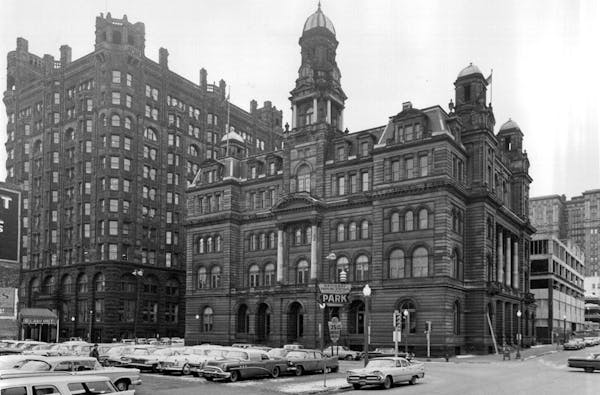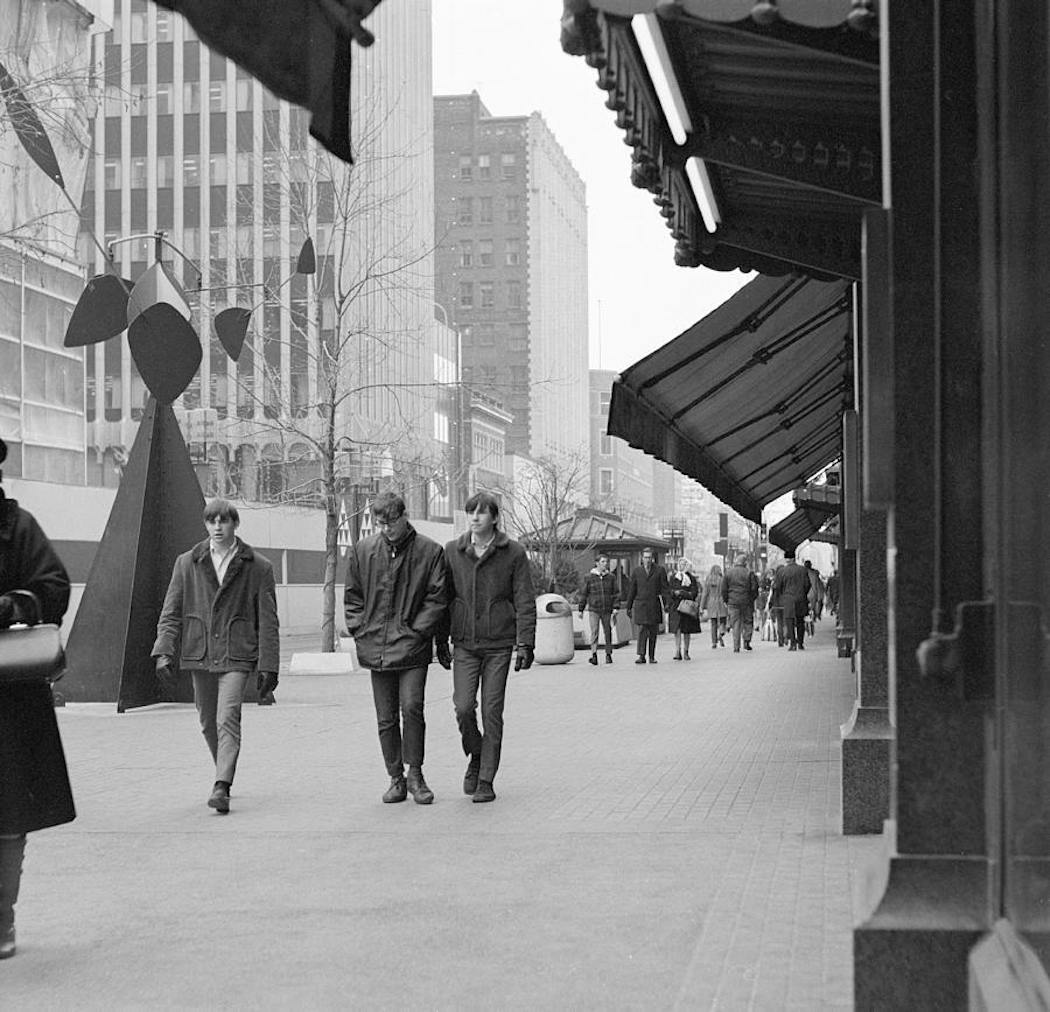In 1964, the Guggenheim Museum in New York City staged an exhibition featuring more than 350 works by Alexander Calder. At the time, it was one of the largest museum retrospectives ever assembled for a living American artist.
The experience struck a chord with Bruce Dayton, an avid and discerning art collector.
"When I went in, I thought it seemed different," he told the Minneapolis Star in November 1965. "It wasn't quiet like some museums are. People were talking and laughing out loud. Children were all over. Touching the pieces of sculpture to hear the tinkle or watch them move. It was really fun to be there."
Dayton and his brothers were running the department store that their grandfather had founded in 1902. At the time, downtown leaders — including the Daytons — were immersed in an ambitious plan to remake eight blocks of Nicollet Avenue into the nation's first pedestrian-transit mall. Trendsetting Dayton's commissioned Calder to create a site-specific work to be placed in front of its mammoth emporium on the new Nicollet.
"[Calder] was definitely inspired by the idea of having a work of his on the main street of Minneapolis," Bruce Dayton told the Star in November 1965, when the commission was announced. "We regard him as the leading sculptor in America today. We certainly feel that a piece of this quality cannot help but be a source of joy and delight."
Calder anchored a delicate, floating mobile on a stabile fashioned from two intersecting black triangles. At their confluence he placed a whirligig-like pair of interlocking discs mounted on ball bearings; painted in vivid red, blue and yellow, they were designed to catch the breeze, which is probably why he christened his work "The Spinner."
Fashioned from steel in Calder's studio in central France, the work weighed in at 1,500 pounds and measured 18 feet high with an 18-foot wingspan. Once it was shipped to Minneapolis, it spent several months under wraps in the store's warehouse, awaiting installation on the still-under-construction mall.
"The Spinner" wasn't the retailer's first brush with high-profile public art. In the early 1960s, Dayton's purchased a Henry Moore sculpture, "Standing Figure: Knife Edge," to adorn a plaza outside its new downtown St. Paul store.
"We've discovered that whether the people appreciate the Henry Moore aesthetically or not, they notice it," Bruce Dayton told the Star. "And they realize that the plaza with the Moore in it has a definite style to it. Good art does speak to people, you know."
'Kind of weird'
"The Spinner" was unveiled on Nov. 20, 1967, in front of a bundled-up crowd estimated at 800 people. Bruce Dayton pulled back a black shroud that had been masking the work from curious eyes. Reaction was mixed.
"I don't know, I'm baffled," is what one woman told the Minneapolis Tribune. "I guess you sort of have to get used to it."
"I've never heard so many people laugh and walk away disgusted," said another unnamed woman. "Here I stood and stood in the cold — for THAT."
Others were delighted.
"I like it," said a college student. "I think it's kind of weird."
Another unnamed woman agreed.
"I can't figure it out, but I like it," she said. "It's supposed to make you think ... try to guess what it is. That's why it's good."
Critics quickly chimed in.
"A fine example of one of America's great artists," decreed Minneapolis Tribune arts critic Mike Steele. "It's an eminently respectable piece with its graceful, floating form which is now so familiar that even the most outspoken critics of modern art should feel comfortable with it on the mall."
Minneapolis Star columnist Jim Klobuchar called it "the artistic emerald of the entire street," adding that he found it "immensely intriguing, standing there as though it had just been created as a special prize for the world's biggest Crackerjack box."
Placing a Calder in the heart of the city was a generous gesture. Although never made public, the price was estimated at $50,000, roughly $375,000 in today's dollars.
Along with Jack Nelson's "Sculpture Clock" (which remains on Nicollet, at 11th Street), "The Spinner" quickly became a symbol of the city's rejuvenated shopping promenade.
Unfortunately, Dayton's contribution to sidewalk artistic vitality didn't last long.
In October 1971, an overhead obstacle intervened. A skyway connecting the store to architect Philip Johnson's IDS Center was in the works, and the second-story bridge was going to crowd "The Spinner" off its Nicollet Mall perch.
Dayton's solution was to donate its kinetic Calder to the Walker Art Center. The timing proved ideal, since the museum's striking new home, designed by architect Edward Larrabee Barnes, had opened just a few months earlier.
Downtown's loss was clearly the Walker's gain. For years, "The Spinner" enjoyed a pride-of-place position on the museum's highly visible terrace facing busy Hennepin Avenue. Every time I passed it — in a car or bus, on my bike, or walking — it made me smile, just as Bruce Dayton had predicted.
Return engagement
Calder died in 1976. Dayton, a model of civic generosity and business leadership, died in 2015.
Today, "The Spinner" is one of 40 works in the Minneapolis Sculpture Garden, a not-so-big-fish in an enormous pond. (In 1987, when construction of what is now Wells Fargo Place eliminated the downtown St. Paul Dayton's elegant plaza, Dayton's donated its Moore to the Walker Art Center. Today, the 9-foot bronze sculpture is also on display in the garden.)
"The Spinner" now sits near a parking lot entrance, a vantage point that suggests a role as a Walmart-like greeter. Which is why I'd like to offer an entirely uninvited suggestion: return "The Spinner" to Nicollet Mall.
The idea has precedent. After all, the Walker has generously placed several sculptures from its enviable collection in Gold Medal Park, adding vitality to that Mississippi riverfront gathering place.
Also, architect Frank Gehry's dramatic "Standing Glass Fish," which anchored the Sculpture Garden's Cowles Conservatory for a quarter-century, is now on display at the University of Minnesota's Gehry-designed Weisman Art Museum.
The Nicollet Mall's drearily monochromatic new design could certainly benefit from a healthy dose of Calder-induced color (which is as vivid as ever, thanks to the museum's diligent stewardship) and wit. Not just anywhere on the mall, either. "The Spinner" belongs on the block where Calder intended it to stand.
True, there's still not enough elbow room on the sidewalk in front of the Store Formerly Known as Dayton's. However, that's not the case on the other side of the street, at the 8th Street corner, where the IDS Tower's crisp, rectilinear blue glass curtain wall would act as a tailor-made backdrop.
A 1966 Alexander Calder, in front of a 1972 Philip Johnson-designed landmark: It would be a midcentury match made in heaven, right?
Well, in downtown Minneapolis, anyway.




